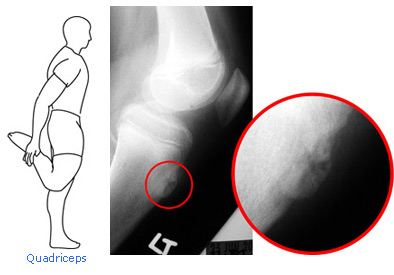 Osgood-Schlatter disease is an irritation of the tibial growth plate just below the knee. The irritation occurs at the tibial tubercle, a normally small bump on the front of the tibia where the patellar tendon has its attachment. The powerful quadriceps muscle in the front of the thigh actually has its attachment (via the knee cap and patellar tendon) to this site. Thus powerful forces are placed on the tibial tubercle in the active growing child.
Osgood-Schlatter disease is an irritation of the tibial growth plate just below the knee. The irritation occurs at the tibial tubercle, a normally small bump on the front of the tibia where the patellar tendon has its attachment. The powerful quadriceps muscle in the front of the thigh actually has its attachment (via the knee cap and patellar tendon) to this site. Thus powerful forces are placed on the tibial tubercle in the active growing child.
Irritation of the tubercle results in localized pain about 2 inches below the kneecap (especially when kneeling or with knee flexion), and often causes a prominence in this area. The condition is most common in athletic males between the age of 10 and 16 but also occurs in females.
Examination
Children with this condition usually have focal tenderness, pain, and swelling over the tibial tubercle, just below the kneecap. The quadriceps tendon is often tight which may contribute to this condition. Both knees may be affected.
X-ray:
X-rays may be ordered by your doctor. Typical findings include irregularity at the tibial tubercle.
Treatment
 The natural history of this condition is for gradual, spontaneous, resolution of symptoms over time as the tibial tubercle fuses to the tibia. Your doctor may recommend an exercise program that includes stretching and strengthening of the quadriceps (muscles on the front of the thigh). Over the counter anti-inflammatory medications like Aleve, Motrin or Advil may be used as directed. Patients may benefit from using a neoprene knee support (sleeve) that can be purchased at a sporting goods store. In rare cases, a short period in a cast may be required to alleviate symptoms.
The natural history of this condition is for gradual, spontaneous, resolution of symptoms over time as the tibial tubercle fuses to the tibia. Your doctor may recommend an exercise program that includes stretching and strengthening of the quadriceps (muscles on the front of the thigh). Over the counter anti-inflammatory medications like Aleve, Motrin or Advil may be used as directed. Patients may benefit from using a neoprene knee support (sleeve) that can be purchased at a sporting goods store. In rare cases, a short period in a cast may be required to alleviate symptoms.
Summary
Osgood-Schlatter disease is generally self-limiting and treatment includes stretching, anti-inflammatory medications, a soft knee sleeve, and/or a short period of immobilization in a cast. Symptoms may continue intermittently for several years.
In general, children are not limited from sports during their treatment for this condition, although they may continue to have some pain. Almost all cases resolve on their own over time and do not require surgery. A few patients will have a relatively large bump at the completion of growth, which serves as a marker that they had Osgood-Schlatter disease in childhood.
For more information, see our KidsHealth article.